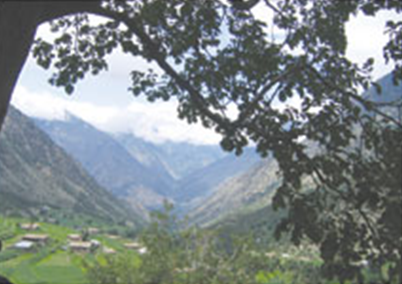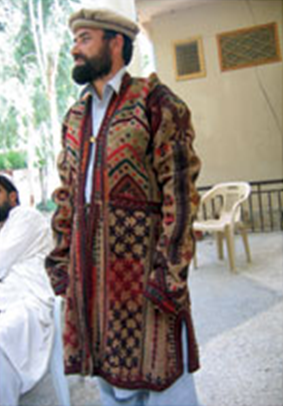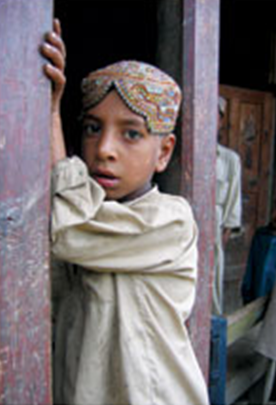Kohistan: Saving its forests
This is a collection of articles archived for the excellence of their content. Readers will be able to edit existing articles and post new articles directly |
Kohistan: Saving its forests
By Rina Saeed Khan
An NGO has worked hard to raise awareness of the value of forests in Kohistan. The 30,000 inhabitants of Palas are clear about one thing -––– they must protect their forests from outsiders and control grazing so that new trees can grow
Piles upon piles of timber lined the Karakoram Highway as we drove up to Pattan (an hour’s drive from Besham). We would turn a curve in the road and then yet another pile of logs would greet us ––– it continued for quite a while and we drove in silence, paying our last respects to the thousands of trees that had borne the brunt of the carnage. They must have slaughtered an entire forest to get so many tree trunks. The piles were almost 10 feet high and they appeared to be Deodar wood -–– it takes almost 100 years for a Deodar tree to mature, hence the horrified silence in the car.
“Yes, there must be over a lakh of trees that are lined up on the road. They claim that they cut these trees back in the 1990s before the ban on logging was enforced in the NWFP, but we are sure that there are many freshly cut ones as well,” we were informed by members of the World Pheasant Association (WPA) who are based in Tehsil Palas in the Kohistan District.
The timber was dragged out from Palas valley and nearby forested areas and lined up on the road only around a year ago. Slowly, it is being sold to contractors who will pay only Rs60 per tree. In Lahore, the same wood will fetch Rs2,200! The Kohistanis are being ripped off by the contractors and they are only now beginning to realise the real value of the precious forests which cover their mountainous ridges. “The people of Palas have become very aware now. They’ve realised the mistake they’ve made by selling their forests. Now some villagers are so wary of outsiders, they won’t even let the Forest Department into their community managed conifer forests,” explains Rab Nawaz, who is heading the WPA and has been working in Palas Valley for over 10 years now.
The NGO has worked hard to raise awareness about the value of the forests in Kohistan. The 30,000 inhabitants of Palas at least are clear about one thing -–– they must protect their forests from outsiders and control grazing so that new trees can grow. “If we can save our forests, it is better for us in the long run,” says Ghulamullah, a local villager. “Slowly, change is coming to Kohistan.”
The Kohistanis are, of course, fiercely opposed to outsiders coming into their valleys and they have been resistant to change for many years. Initially, Rab Nawaz had a hard time winning over their trust. It is not easy to just walk into Palas Valley unless you know the local villagers or are accompanied by members of the NGO.
The local people are generally a suspicious lot -––– their homes are perched on mountaintops and yet even those homes have small towers with gun turrets! Feuds over land holdings and women are commonplace. Women don’t have many rights here and observe strict purdah. There are no schools for girls and only a few primary schools for boys. The people are staunchly religious and follow an austere interpretation of Islam. They all voted for a Maulvi in the last elections, although next year they say they will ‘wait and see’. This is a highly conservative and closed society. However, the twenty first century is intruding -–– just across the bridge over the Indus lies the KKH which has opened up so many other remote mountain valleys in this region.
The picturesque Palas Valley, its mountain ridges hidden in clouds, lies just opposite the town of Pattan on the KKH and has long been known in scientific circles both in Pakistan an abroad as a biodiversity hotspot. Half the valley, which is 1,300 square km, lies inside the monsoon belt while half is outside and the great range in altitude means that there is a great variety of habitats, from sub-tropical to alpine. Upper Palas has pristine forests, home to rare species of pheasants like the Western Tragopan which was thought to be extinct but was spotted and then captured on film in the valley by the late wildlife cameraman Reza Abbas (he recently passed away in Karachi).
The people of Palas have always respected their natural environment. They consider it unlucky to cut a green tree in spring, but they do have to feed their children as well and Kohistan is a poverty stricken region where jobs are rare and every day is a struggle for survival. People own small plots of terraced land and basically live off what they can grow. Many men go in search of work in Karachi and other large cities.
During our visit to Sherakot village in Palas Valley, we met a school boy who had won an award for his poem which was about how ‘life is expensive but death is cheap in Kohistan’. The mountain people, with their tall physiques and rugged good looks have survived for centuries in this harsh albeit beautiful environment. But the recent earthquake that hit Pakistan on October 8, 2005 devastated many of their homes. Although there was relatively little loss of lives since most people were out in the fields, almost a 1,000 houses were destroyed. The houses near the forested areas, however, were saved. The trees had protected them from landsliding.
With winter only a few months away, the people of Kohistan have wisely decided to go ahead and rebuild their homes and not wait for handouts from the government. As a result, however, more trees have had to be cut in the area for construction purposes. We climbed up to a mountain ridge above the earthquake hit village of Sherakot and were distressed to see more conifer trees that had been freshly cut. A half hour’s walk into the forest, however, and we came into densely forested mountainsides where the only sounds one heard was the cry of birds. Unfortunately, we could not make it into upper Palas with its pristine forests full of pheasants, as the jeep track leading into that part of the valley was damaged by recent landsliding. The forests in this part of Palas have been saved because they are a full one day’s trek by foot from the jeep track. The timber mafia couldn’t get into the upper part of this valley.
We spent our two days in Palas visiting the nearby villages and learning about the Palas Non Timber Forest Products Management Project, initiated by the NGO. The idea is to provide alternatives to commercial timber cutting. The project helps the local people to grow fruit trees like walnut and apple in order for them to make some extra money. The project also teaches them about the various medicinal plants that are found in the forests which can be used for the treatment of both humans and livestock and which have cash value. The NGO has hired a local hakeem to compile a herbarium that has more than 100 sheets on each medicinal plant and its value.
They have also provided some homes with honeybee boxes that have indigenous bees. The honey can be sold in the local market and provide income to households. In Upper Palas, there are many chilgoza forests and the NGO is also teaching them how to extract the chilgoza nuts without damaging the trees. They are also teaching the local villagers how to market the nuts and sell them in the bigger markets. “Slowly, people are becoming aware of the benefits of all these trainings,” says Mohd Nawaz, a local villager. “We have formed a special interest group and we will be selling the chilgozas together in September after harvest time.”
The aim of the project is to conserve the moist temperate forests of Palas Valley by introducing the concept of managing non timber forest products. The project is working with community based organisations in the valley and is funded by the UNDP’s Small Grants Programme to Promote Tropical Forests. The process is slow but word is spreading throughout the valley and even villagers outside the project area now want to participate in the project. The local villagers understand that they can make more money from these yearly activities than by selling their timber every 20 years.
The forest can yield so many more valuable products –––– mushrooms, wild fruits, vegetables ––– which if marketed properly can be sold for profit in the large towns and cities of Pakistan. Imagine eating fruit and vegetables that have not been treated with pesticides or fertilizers. The KKH is so close that transportation would not be a problem. The forests of Kohistan can be saved if the people realise the value of the treasure they contain within their thick foliage.
Rab Nawaz, a Welsh ecologist, has been working in Palas Valley for the last10 years. “Our interventions in Palas have been successful, however, it will take time to establish a sustainable system,” says the shy and unassuming man who runs the World Pheasant Association’s office in Abbotabad and has worked in Palas Valley since 1996.
Dressed in shalwar kameez and sporting a long beard, he could easily pass for a blue eyed Pathan. He speaks Urdu and Shina (the local Kohistani language) fluently. It is hard to believe that he was once Rob Whale, a young Welsh ecologist who had come to Pakistan in 1994 to help conduct a survey of pheasants in Pakistan’s frontier region.
Before coming to Pakistan, Rab Nawaz had been working on an estate owned by the President of the WPA International. Hailing from Wales which is known for its lush and beauty, his love of wildlife and particularly wild birds was an inheritance from his naturalist grandfather, with whom he used to spend his holidays as a boy. Roaming all over coastal Wales the two would go bird-watching, so that it was no wonder that all he ever wanted to do was become a gamekeeper, working closely with nature.
At the age of 16, he did a game-keeping course and was hired on an estate whose owner, to Nawaz’s dismay, used to keep live birds as captive ornaments. “However, it was a wonderful experience and I stayed on there for the next three years,” he remembers. It was during his college years in Hampshire that he came into contact with Keith Howman of the WPA (World Pheasant Association) who offered him a job on his estate. Here he was able to meet wildlife experts from all over the world, a learning experience for the aspiring conservationist.
After spending a couple of years on the estate and completing his studies, Rab Nawaz thought it was time he tested his wings and decided to work in India on the endangered Indian Tragopans. His work and zeal so impressed the WPA that they asked him to come to work in Pakistan.
Looking for a job and attracted by the challenge posed by WPA’s work in Dhodial, he decided to move to northern Pakistan. After working with captive wild pheasants, he and the WPA realised that the best way to start saving pheasants in the wild was to observe and record changes in pheasant numbers and habitat in the northern region and pinpoint the factors responsible for their decline.
This proposal, which was supported by the NWFP Wildlife Department and the UNDP’s Small Grants Programme, turned into an activity that lasted from 1996 to 1999.
Gradually, feeling more at home amongst the dramatic mountains and wildlife of north Pakistan than in England, Nawaz developed a strong bond and affinity with the land. So that when in 1998, after completing the pheasant research, he was jobless and faced with the option of leaving Pakistan, he chose to stay on. He joined the WWF, where he is now working in the remote Palas Valley in the Kohistan. The work he has done with the pheasants has earned him the respect and admiration of the local conservationists.
In the years he has been in Pakistan, Nawaz has spent long months in the isolated valleys of the NWFP, where his only human contacts are the local villagers. Through his fieldwork, he has had ample time and opportunity to closely interact with them. Observing local culture and he has been fascinated with the dissimilarity between tradition and religion.
“It makes me very angry when people don’t observe the wisdom of their religion and confuse tradition with religion,” he says. His fascination with Islam prodded him to study it in detail for nearly two years. “Someone gave me an English version of the Quran by chance and after studying it I came to the conclusion that it could not have been written by a man,” says Rab Nawaz. “So I woke up one day and realised that I wanted to convert to Islam.”
He converted to Islam in 1998, changing his name to Rab Nawaz. “I had no problems with that,” he says with a laugh. “People find it easier to accept me as one of them with this name and since I am living here I thought I might as well change it. Besides I like the name Rab Nawaz (which translates into ‘Grace of God’).”
To complete his naturalisation into Pakistani society, Nawaz married a Pakistani woman in 1999, and they live together in Abbottabad. “It was an arranged marriage,” he says. “My friends knew her family and they suggested me to them.” Conversion to Islam and marriage has, he believes, changed him profoundly and for the better.
According to Rab Nawaz, putting out these roots has strengthened his links to his adopted country, particularly Palas Valley that has inspired him with its beauty. “It is very special to me,” he explains. “Due to its inaccessibility, its forests and rivers are undisturbed. I can’t explain what draws me to this beautiful valley. Though it is a difficult place to stay and work in and the people are also sometimes hard to deal with, yet it is still very important to me.”
This article is an excerpt from the book ‘Green Pioneers’, edited by Mehjabeen Abidi-Habib






